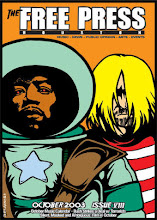Classic Interviews: Jim Jarmusch

Every so often Free Press Houston visits the classic interview bag, this week we came up with our conversation with Jim Jarmusch conducted while he was promoting the Neil Young documentary Year of the Horse.
Rock and roll will never die, especially when it's captured on film stock. Jim Jarmusch, indie-minded writer/director of Mystery Train, Stranger Than Paradise, and Dead Man, took the assignment to chronicle the 1996 Crazy Horse tour after having collaborated with Neil Young on the soundtrack to Dead Man. Call it two iconoclasts jamming in synch, one on guitar, the other with film emulsion, and you've got the heart of Year of the Horse.
The only thing that could possibly be better with this dead-on performance film would be if it was projected in an digital stereo THX-enforced theater. It's not, but the Landmark Greenway Three has assured that the volume will be cranked the fuck up.
Jarmusch used super-8 (three stocks: high speed color negative, Ektachrome, and Tri-X) and 16mm, which he seamlessly blends with footage of Crazy Horse shot in 1976 and 1986. Year of the Horse alternates complete live song segs with vignettes of the band. The 107-minute film closes with a version of "Like a Hurricane" that uses footage from Crazy Horse's 1976 perf at the Hammersmith Odeon immaculately intercut with last year's footage from a concert at The Gorge (off Interstate 90 near George, Washington).
"It flowed together, man, we only fooled with a few frames of image, but the sych was fine, so were the tempo and the pitch," Jarmusch told Free Press Houston in a phone interview regarding the "Hurricane" sequence. "Twenty years later it just melted right into it."
Young contacted Jarmusch about going on the road to shoot concert footage after Jarmusch had done a music video for "Big Time," also shot in super-8. "This film had no intention to it," said Jarmusch. "I asked how long a film he was thinking of making and he said 'Hey, when I start writing a song I don't think about how long it's going to be.'"
Jarmusch intends his film to paint of true portrait of a band on the road, without pretending that he understands 30-years of a band's heart. Young, who also directed the musical movie Journey Through the Past, commissioned a crew to shoot concert footage in 1976, which resides in Young's archives and was used in Year of the Horse. "The stuff from 1986, Neil shot himself on video," said Jarmusch, "And he made a beautiful film called Muddy Track, which is finished but has never been released." Jarmusch lifts footage that can be narcissistic but yet revelatory. One passage which a raging argument pretty much sums up the band's stake in the world of rock 'n roll. "They're not arguing about some rock star drama, like why aren't there pimentos in the olives," noted Jarmusch. "They're arguing about their art, their expression, and they take it real seriously," added Jarmusch. "It comes from their souls and they're very pure about that."
On his decision to give the film a gritty look, yet the look of film, Jarmusch explained: "Video is immediate, but it's not beautiful. Film has light passing through it when you expose it, and video is dead where no light passes through anything. It's pixels on a digital palette. But it's a good tool for certain things.
"I've had to fight to make films in black-and-white. I had to shot Dead Man on a budget lower than I needed to make the film, whereas I could've gotten the budget if I'd made it in color. No, it was black-and-white in my head when I sat down to write it and it's going to be black-and-white on the screen.
"Are you telling me that since photography was invented nobody's allowed to paint? Are you telling me that now that we have computers that pencils are illegal? Sometimes you need a hammer and a chisel and you don't need a chainsaw."
Jarmusch considers himself a "guy from Akron," where he grew up yet has little intention of ever returning. His father worked for B.F. Goodrich, his uncle worked for Goodyear, one neighbor worked for Firestone, another neighbor worked for General Tire. "They used to have a hotel with a lounge on the top called the Rubber Room. My mother saw Gene Krupa play the Rubber Room," recalled Jarmusch, ever the embodiment of the New York filmmaker. "That's as high as culture gets in Akron."









0 Comments:
Post a Comment
<< Home